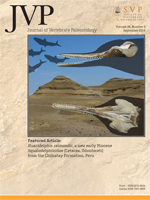Kentriodon hoepfneri, sp. nov., is described from elements of the skull and a nearly complete vertebral column from middle/upper Miocene deposits of Groß Pampau, northern Germany. The new species is distinguished from previously described species of Kentriodon Kellogg, 1927, by anteromedially globular nasal bones and a narrowly elliptical posterior buhar facet of the periotic. In the size of its skull and teeth, overall morphology of the periotic, and the pentagonal shape of the nasal, the new species most closely resembles Kentriodon pernix and the probably congeneric Belgian specimen IRSNB M.372. The proportions of the vertebral centra indicate similarities with extant ziphiid and monodontid cetaceans, with greatest flexibility of the body in the lumbar region. Kentriodon hoepfneri, sp. nov., is the youngest known member of the kentriodontine subfamily to date. Among the subfamily Kentriodontinae, Kentriodon is the only genus with a Transatlantic distribution during the Miocene.
How to translate text using browser tools
1 September 2014
A New Species of Kentriodon (Mammalia, Odontoceti, Delphinoidea) from the Middle/Late Miocene of Groß Pampau (Schleswig-Holstein, North Germany)
Emese Kazár,
Oliver Hampe
ACCESS THE FULL ARTICLE





